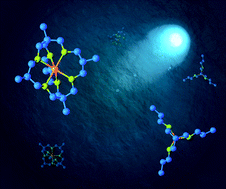Octahedral and trigonal prismatic structure preferences in a bicyclic hexaamine cage for zinc(ii), cadmium(ii) and mercury(ii) ions†‡
Abstract
The synthesis and characterisation of complexes of the hexaamine cage ligand facial-1,5,9,13,20-pentamethyl-3,7,11,15,18,22-hexaazabicyclo[7.7.7]tricosane (fac-(Me)5-D3 htricosaneN6) with Zn(II), Cd(II) and Hg(II) is reported. Single crystal X-ray structural analyses of the Cd(II) and Hg(II) complexes reveal that the coordination spheres of both cations have an unusual trigonal prismatic stereochemistry organised by the ligand substituents and cavity size. This is unprecedented for hexaamine complexes of these metal ions, and in stark contrast to the distorted octahedral stereochemistry found previously for the analogous Zn(II) complex. An X-ray structural analysis of single crystals of the diprotonated ligand [fac-(Me)5-D3htricosaneN6 − 2H](CF3SO3)2 shows that it also prefers to adopt a trigonal prismatic structure. The 13C NMR spectra of the metal complexes indicate that their structures are preserved at 20 °C in solution. However, heating the Zn(II) complex to ∼130 °C appears to convert it to the trigonal prismatic form. In contrast cooling the trigonal prismatic Hg(II) complex to −80 °C does not convert it to the octahedral structure. The results are also compared to the structures of various other transition metal ion complexes of the same or similar ligands. This comparison yields overall an appreciation of the factors that determine the final structures of complexes formed with such tricosaneN6 ligands.


 Please wait while we load your content...
Please wait while we load your content...